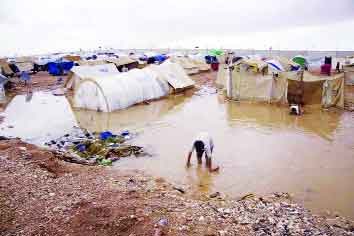India must focus on all elements of degradation and seek solutions that can fundamentally transform key social and economic systems and make them resilient to changing climate patterns
High incidence of climate-related events such as flash floods and droughts has increased dramatically over the past few decades. Nature-related flashpoints are now assuming disturbing proportions and can be listed as a part of a pattern relating to the breakdown of the environment. Consequent changes in the environment at the national and international level have immense ramifications for indigenous societies and economies. Marked changes, for the worse, do not fail to register on the general public, who are scrambling to adjust to changing scenarios. But damage is still being done.
Nations across the world have failed to recognise that human impacts on the environment have reached a critical stage and have the potential to erode conditions upon which socio-economic stability is dependent. Human-induced environmental change is occurring at an unprecedented rate and the window of opportunity to avoid catastrophic outcomes in societies around the world is closing rapidly. These outcomes include economic instability, large-scale involuntary migration, conflict, famine and the potential collapse of social and economic systems.
Historical disregard to environmental considerations in most areas of policy has been a catastrophic mistake and is now spewing undesirable dividends in the form of temperatures, which have risen to such an extent that the 20 warmest years on record have been in the past 22 years, with the past four years being exceptional. Coupled with this is the fact that vertebrate populations have fallen by an average of 60 per cent since the 1970s and more than 75 per cent of the Earth’s land areas have been degraded substantially.
The fact that environmental breakdown is occurring in real- time is proven by the fact that since 2005, the number of floods across the world increased by 15 times, extreme temperature events by 20 times; and wildfires seven-fold. Wildlife extinction rates, on the other hand, have increased by 100-1,000 times. Apart from this, top soil is now being lost 10 to 40 times faster than it is being replenished by natural processes. And since the mid-20th century, 30 per cent of the world’s arable land has become unproductive due to erosion; 95 per cent of the Earth’s land areas could become degraded by 2050.
Even as these disconcerting developments are gaining momentum, measures to arrest the same are at best feeble. As environmental breakdown becomes more of a reality every passing day, complex natural systems are becoming more destabilised. Consequences of this destabilisation are manifesting in the form of extreme weather events and soil infertility, which in turn impact human systems from local to global levels. This process is already under way, damaging human health and driving forced migration and conflict around the world. This phenomenon is set to accelerate as breakdown increases. Due to the high levels of complexity, the scale of breakdown and systemic nature of the problem, responding to the age of environmental breakdown may be the greatest challenge that humans have faced in their history.
The consequences of environmental breakdown will fall hardest on the poor, who are most vulnerable to its effects and least responsible for the problem. It is estimated that the poorest half of the global population are responsible for around 10 per cent of yearly global greenhouse gas emissions; with half of emissions attributed to the richest 10 per cent of people. Within rich countries, the wealthiest 10 per cent contribute far more to greenhouse gas emissions than other income groups. In the UK, for instance, per capita emissions of the wealthiest 10 per cent are up to five times higher than those of the bottom half. In addition, environmental breakdown interacts with other inequalities, such as class, ethnicity and gender. This makes environmental breakdown a fundamental issue of justice.
There is an urgent need to see the environmental problems around us as a part of an evolving pattern in order to find a solution. This will help fast developing countries like India to avoid the ill effects of this breakdown. We must, hence, seek solutions that can fundamentally transform key social and economic systems and make them resilient to changing climate patterns. This will also make societies and communities at the grassroot level robust enough to face the increasingly severe consequences of the breakdown. Additionally, India must also rally the support of the world in fighting for the cause of global environment that has paid the price for growth of the developed nations. Degraded environment will take hundreds of years to recuperate. Hence, it’s important to stop the environmental breakdown now.
(The writer is an environmental journalist)


























